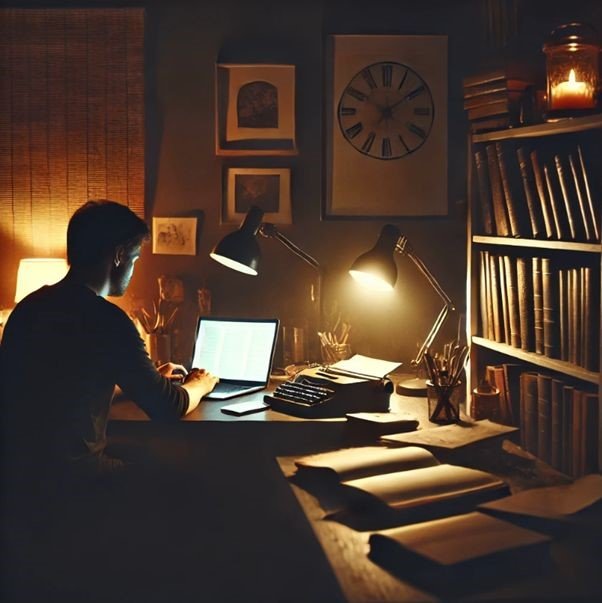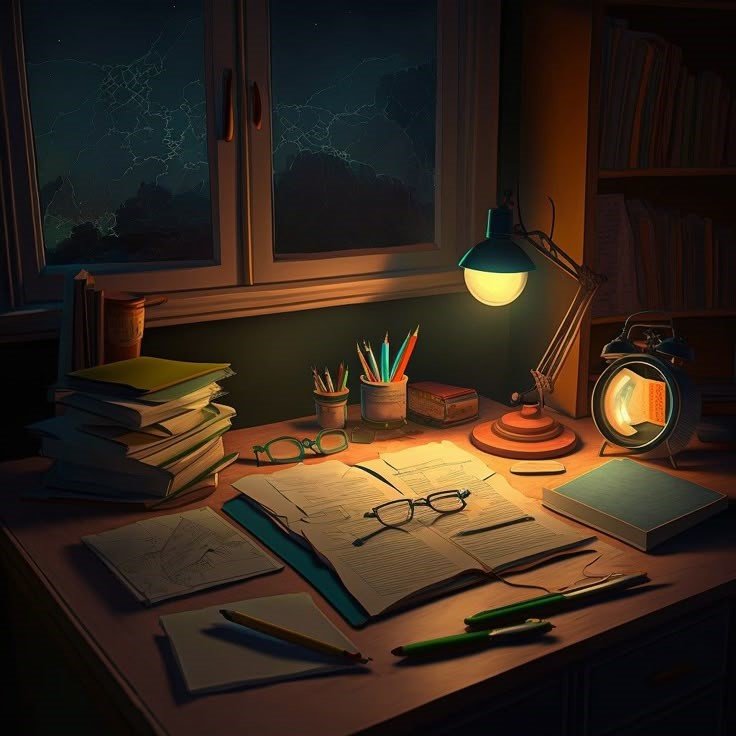Why Do ADHD People Work Better at Night?
I’ll be honest with you, I’ve lost count of how many times clients have told me, “I just can’t get anything done during the day, but at night… it’s like my brain finally wakes up.”
If you live with ADHD, maybe that sounds familiar. The world gets quiet, your phone stops buzzing, no one’s asking for “just a quick thing,” and suddenly, boom, you’re in the zone. Tasks that felt impossible at 2 p.m. become strangely effortless at 10 p.m.
I remember one client (let’s call him Daniel, a college student in Los Angeles) who could barely write a paragraph in the library during the day. The noise, the distractions, the constant movement, it was all too much. But come midnight, he would sit in his dorm room, headphones on, and crank out five pages in a single sitting. He’d laugh and say, “I don’t know why I can’t do this at 3 in the afternoon. But at night? My brain just… works.”ADHD
And he’s not alone. Research shows that many adults with ADHD experience a kind of nighttime productivity window. Some call it hyperfocus. Others call it procrastination’s last stand. But the truth is, there’s something deeper going on in the ADHD brain.

In this article, we’re going to explore:
- Why ADHD brains often focus better at night
- The role of circadian rhythms, sleep cycles, and melatonin issues
- How daytime distractions sabotage focus
- What research studies tell us about nighttime ADHD energy peaks
- Practical coaching strategies for harnessing night focus without burning out
- And yes, a few real-life stories (because science is important, but lived experience makes it real)
So, if you’ve ever wondered why your ADHD brain comes alive after dark, and how to make that work for you instead of against you, you’re in the right place.
Problem Identification – Why ADHD People Focus Better at Night
The ADHD Night Focus Phenomenon
Here’s the strange thing: when most people are winding down for the night, many adults with ADHD are just getting started. While friends and coworkers are yawning, you might suddenly feel a burst of clarity, ideas flowing, tasks getting done, focus that was nowhere to be found all day.
It’s not just “bad habits” or procrastination. There’s real science behind this.

Researchers studying ADHD and sleep patterns have found consistent differences in circadian rhythm (our body’s natural 24-hour clock) compared to the general population. In fact, ADHD brains are often described as “delayed”, meaning their internal clock runs late.
Circadian Rhythm Disruptions in ADHD
A landmark actigraphy study published in Sleep (Boonstra et al., 2007) tracked activity levels of adults with ADHD. What they found was fascinating:
- ADHD adults showed delayed sleep phases, meaning their bodies naturally wanted to fall asleep later.
- Their energy and alertness spiked in the evening, not the morning.
- Even when treated with medication (like methylphenidate), these patterns persisted.
In simple terms: many ADHD brains are wired to be night owls.
Delayed Sleep Phase & Melatonin Issues
Normally, melatonin (the “sleep hormone”) begins rising in the evening to help signal bedtime. But in ADHD, studies suggest melatonin release is often delayed by 1–2 hours. That means while most people are feeling sleepy at 10 p.m., someone with ADHD might not feel drowsy until midnight, or later.
This delay creates a mismatch: the world expects you to work, study, and function during the day… but your brain is still “warming up.” By the time your focus kicks in, the rest of the world has gone to bed.
Daytime Distractions vs. Nighttime Calm
Another major factor? The environmental shift at night.
During the day, the ADHD brain is bombarded with:
- Noise (traffic, coworkers, kids, phones)
- Constant interruptions
- Demands and multitasking pressure
For someone with ADHD, whose brain already struggles with filtering distractions, this overload is exhausting.
But at night? The phone stops buzzing, emails stop coming in, and the world finally slows down. That quiet is like oxygen for the ADHD mind. Suddenly, hyperfocus can take over, and you ride that wave until the early hours.
The Role of Hyperfocus
Hyperfocus is one of ADHD’s most misunderstood traits. It’s not that people with ADHD can’t focus, it’s that focus often shows up unpredictably, and sometimes only when external distractions disappear.
At night, the ADHD brain may “lock in” on a task, achieving hours of deep productivity. Of course, this comes at a cost: sleep deprivation, burnout, and struggling the next day. But in the moment, it feels like a superpower.
Real-Life ADHD Stories – Why Night Feels “Easier”
Stories bring research to life. I’ve seen this “night focus” pattern play out again and again with clients, different backgrounds, same late-night clarity. Here are three anonymized examples that illustrate how ADHD brains come alive after dark.
Story 1: The College Student Who Couldn’t Write in the Daytime
Daniel (not his real name), a sophomore at UCLA, dreaded daytime study sessions. The campus library was buzzing with activity, phones were pinging, friends were stopping by. His ADHD brain couldn’t block it all out.

Every time he tried to start his essay, he ended up scrolling social media, wandering the stacks, or reorganizing his backpack for the fifth time. By 4 p.m., he was frustrated and defeated.
But midnight told a different story. When his dorm hall went quiet and the distractions faded, Daniel’s brain lit up. He could finally channel his thoughts into writing. Sometimes he’d stay up until 3 a.m., but by morning he’d have a polished draft ready to go.
He told me once, “It’s like my brain was waiting all day for everyone else to go to sleep so it could finally focus.”
Story 2: The Night-Shift Nurse Who Thrives After Hours
Another client, Marissa, worked as a nurse in San Diego. She’d struggled in traditional 9-to-5 jobs, always late, always tired, always scrambling to meet deadlines.
But when she transitioned into night shifts at the hospital, something clicked. Her ADHD brain finally lined up with her work environment. She described it this way: “During the day, my head feels foggy, like I’m moving through molasses. But at night, I’m sharp, calm, and efficient.”
Her circadian rhythm, which was naturally delayed, matched her work schedule. For the first time, she wasn’t fighting her body’s clock, she was working with it.
Story 3: The Freelance Designer Who Uses Midnight Hyperfocus
Sam, a freelance graphic designer in San Francisco, found his most creative bursts always came after 10 p.m. He’d spend the day chasing invoices, answering emails, and trying to sit through meetings (usually zoning out halfway). But at night?
That’s when the ideas flowed. He’d put on music, open Photoshop, and lose track of time in hyperfocus. Some of his best projects were completed between midnight and dawn.
The downside? His sleep suffered, and balancing client deadlines with his “ADHD night shift” wasn’t always easy. But with coaching, he learned to set boundaries, using nighttime for deep creative work while protecting rest with strict cut-off times.

Practical ADHD Solutions – Step-by-Step Coaching Strategies
Now that we’ve looked at the why, let’s get into the how.
Because while it’s true that many people with ADHD work better at night, the trick is learning to leverage that night focus without wrecking your health, career, or relationships.
Here’s how I guide my clients through it, step by step.
Step 1: Identify Your Personal Focus Window
There is not a single time where the ADHD brain lights up. For some it’s 9 p.m. – midnight. For others it’s 11 p.m. – 3 a.m.
The first step is to track your natural rhythms
- Keep a simple log (or you could use an app like Toggl Track or RescueTime) and write down what time you feel most energized.
- Examine the comparison of your focus levels at different times of the day.
- After 1-2 weeks, you will see books, Special Interest Activities, or passion projects that correspond to your personal “ADHD night peak”
Coaching tip: I often recommend clients try actigraphy-style tracking apps (like Sleep Cycle or Oura) to better understand their sleep/focus patterns.
Step 2: Protect Nighttime for Deep Work
Once you have established your focus window, please protect it for your most important tasks.
That means:
- Don’t waste all your night energy on emails or chores.
- Use it for the creative or problem-solving effort, or anything that really takes brainpower.
- If you live with family or roommates, communicate ahead of time that you are working deep in thought during your “deep work hours,” and ask them to respect that.
Coaching tip: Create a “night ritual” that signals your brain it’s time to work, like dimming lights, playing a certain playlist, or making tea.
Step 3: Set Boundaries Around Sleep
Here is the danger: when hyperfocus is activated, you can lose whole hours just like that. One moment it’s 10 pm and the next it’s 4 a.m., ruining tomorrow.
To mitigate this risk:
- Set a time limit with either a timer or a smart home device alive Alexa or Google Home to trigger “wrap-up time.”
- Try to have a cut-off hour that is consistently available for the evenings (i.e. 1 a.m. does not feel too late).
- Experiment with blue light blocking glasses and screen blue light filter tools to minimize circadian disruptions.
Coaching tip: I sometimes have clients set up “future reminders” (like a scheduled email or calendar alert) that says, “Hey, remember tomorrow-you needs sleep too.”
Step 4: Balance Day-Night Energy
You can’t live permanently on the night side of your circadian cycle. So the goal here is balance.
Some practical examples of strategies to use include:
- Nap in the late afternoon strategically (20-30 minutes)
- Engage in bright light therapy in the AM for circadian timing to shift
- Plan low-demand tasks during daytime sluggishness
Coaching piece: I tell my clients to think of their day in waves of energy to ride, rather than fixed organizational schedules. When the focus wave comes, ride it! Plan the easier stuff when you feel the wave of energy crash.
Step 5: Use Tools That Support Executive Function
ADHD is about more than the when you can focus, it’s about the managing of that focus.
Helpful tools include:
- Pomodoro timers to prevent all-nighters
- Project boards (Trello, Notion, Asana) to keep track of tasks
- Accountability buddies (check-in texts at night so you don’t spiral too far into hyperfocus)
Coaching piece: Sometimes the most powerful tool is the simple act of external checking. One client decided to have his roommate knock on his door at 1 a.m. every night and say, “sleep” to him. It seems ridiculous, but it worked.
Troubleshooting & Challenges – When Nighttime Focus Backfires
Night focus can feel like a gift, but unmanaged, it can quickly become a curse. I’ve seen clients burn out, miss work, and even damage relationships because their nighttime productivity threw their lives off balance. Let’s look at the common pitfalls, and what you can do about them.

Challenge 1: Sleep Deprivation
The problem:
You’re in hyperfocus mode until 3 a.m., then you crash. The next day you’re groggy and late for work, and the cycle continues.
The fix:
- Establish a “bedtime boundary” (use alarms, timers, even apps like SleepTown)
- Schedule your ritual of wind-downs: dim lights, meditation, journaling
- If you’re working late, lay claim to the next day with a power nap or easy schedule
Coaching insight: I remind clients that one great night of productivity is worthless if it costs you three days of recovery.
Challenge 2: Occupational Conflicts
The problem:
Your productivity windows don’t align with the 9 to 5 world. Employers expect daytime energy and you’re only half-asleep.
The fix:
- If you can, ask for flexible work hours, or remote work with flexible hours
- Stack your morning with administrative tasks (emails, etc.) and use your creative time later
- If you are a student, take classes in the afternoon/evening when available
Coaching insight: One of my clients, a programmer, arranged with his team that code reviews were due by midnight, instead of morning. It was a great compromise for productivity and his manager.
Challenge 3: Family & Relationship Tension
The problem:
Your focus at night means that your partner is going to bed alone, or your kids lose their morning time with you. All relationships suffer.
The fix:
- Openly communicate: “My brain works differently and I want to have a connection. Can we set a designated time before my work window starts?”
- Build shared rituals (dinner, bedtime story, a nightly check-in) before diving into night work.
- Use part of your daytime “low-focus” hours for bonding, even if it’s not your most productive time.
Coaching insight: ADHD night focus shouldn’t come at the cost of connection. Protecting relationships is as important as protecting productivity.
Challenge 4: Health & Burnout
The problem:
The health problems associated with irregular sleep impact hormones, mood, and long-term health. ADHD brains are more affected by anxiety/depression and sleep deprivation makes these problems worse.
The fix:
- Get morning light therapy lamps to help regulate your rhythm.
- Limit caffeine after 2 p.m. (yes, even if it “doesn’t affect you”).
- Work with a doctor if delayed sleep phase or insomnia is severe.
Disclaimer: These are coaching strategies, not medical advice. Always consult with a licensed professional for health concerns.
FAQ – ADHD & Nighttime Focus (Featured Snippet Optimized)
Here are the most common questions I hear from clients about ADHD and why they work better at night. These are formatted to be clear, scannable, and snippet-friendly for SEO.
Q1: Why do people with ADHD focus better at night?
A: The ADHD brain tends to have a delayed circadian rhythm, requiring more time to reach alertness. Less noise and distractions are present in the evening with a more calming environment, and the chances of a natural spike in alertness occur later in the day. Hyperfocus may happen easier in the evening because of fewer external interruptions.
Q2: Is it normal for adults with ADHD to be night owls?
A: Typical. Many adults with ADHD face Delayed Sleep Phase Syndrome, which means their circadian rhythm naturally runs much later than the normal 9-5. Research supports that this is a common experience for some, not abnormal.
Q3: Does melatonin help ADHD night focus?
A: Not necessarily. Melatonin may help with sleep onset, but the brains of those with ADHD often have issues with melatonin timing. This is one of the reasons that melatonin in common doses does not have the same effect on your sleep rhythm. Using something like light therapy or changes to your schedule, may be a better fit for night-focused work .
Q4: Can ADHD medication affect nighttime productivity?
A: Yes! Stimulants like methylphenidate can help with daytime focus, but may inhibit your ability to sleep if taken late in the day. So it is important to know how your medication fits into your body’s natural timing. Always consult your doctor before changing medication or dosages.
Q5: Should I force myself to work in the morning?
A: Not necessarily! Forcing yourself to work in the morning will only cause frustration and reduced output and may lead to burnout. Take advantage of your natural night focus area, but save low-demand tasks, telephone and Zoom meetings, writing and planning during the daytime.
Q6: How can I balance night work with health and relationships?
A: Key strategies include:
- Being more disciplined – that is, setting a cut-off time to help protect your sleep
- Talking with your family or housemates
- Using tools like tomato timers or your project board
- Taking note of your health or productivity measures
We’ve covered why ADHD brains often thrive at night, the science behind circadian rhythms, real client stories, step-by-step strategies, troubleshooting, and success metrics. Now let’s tie it all together and make it actionable.
Final Thoughts
Nighttime productivity isn’t a flaw, it’s a feature. For many adults with ADHD, the evening brings focus, calm, and hyperfocus that daytime hours simply cannot match. The key is leveraging this natural pattern while protecting your health, relationships, and responsibilities.
Remember:
- Track your personal focus window
- Protect deep work sessions
- Set boundaries to safeguard sleep
- Balance night energy with daytime obligations
- Use tools and strategies to support executive function
By understanding your brain’s rhythm and coaching yourself effectively, you can turn what might feel like “procrastination” into a sustainable ADHD superpower.
Ready to harness your night focus without burnout? Here’s what you can do next:
- Book a session with our expert ADHD coaches: Heal-Thrive Coaching
- Download our free guide: ADHD Night Focus: Strategies for Productive Evenings (link to PDF)
- Subscribe to our newsletter for weekly tips on ADHD executive function, sleep, and productivity.
